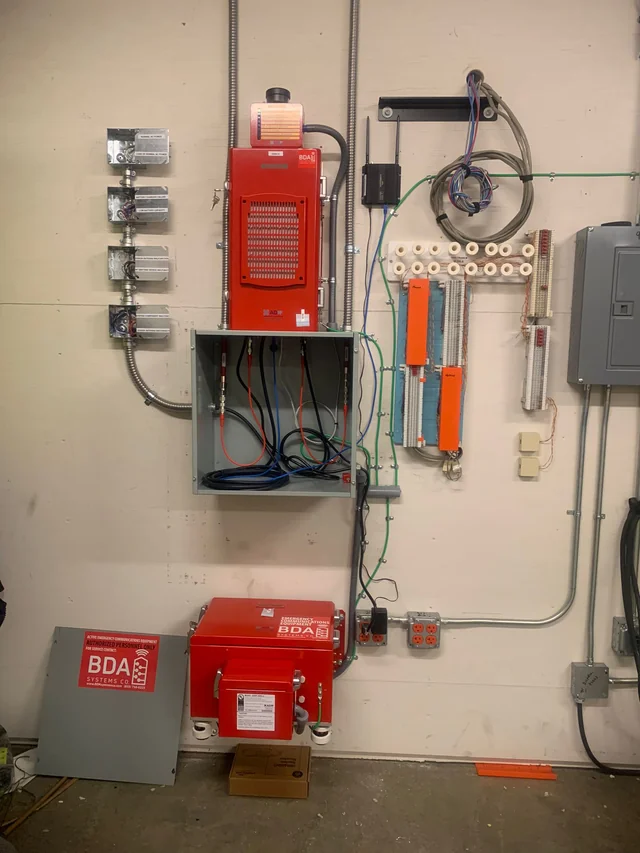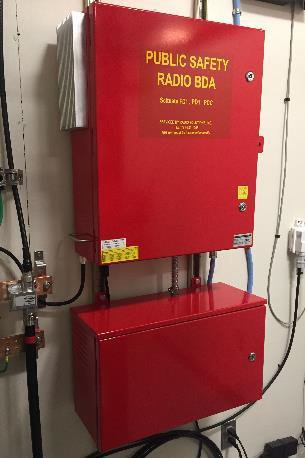Executive Summary
A large regional medical campus with five connected buildings was facing an occupancy renewal and a life safety audit. Public safety radio coverage was failing in key areas, which put the schedule at risk. Maximum Communications designed and installed a Class A public safety BDA system. The campus passed AHJ acceptance on the first try. Coverage, DAQ, and reliability improved across all critical spaces.
Client
The client is a regional medical campus with a trauma center and specialty clinics. Thousands of staff, patients, and visitors move through the site every day. Reliable public safety radio was essential for daily safety and emergency response.
Goal
The goal was to pass the occupancy renewal and life safety audit while maintaining reliable public safety radio coverage in every required area. All work needed to protect patient care, sterile environments, and emergency routes during construction.
Challenge
A pre audit RF assessment found widespread dead zones on lower floors, in stairwells, and throughout the underground garages. Voice intelligibility fell below jurisdiction thresholds in fire command areas and service corridors. Median downlink in sub grade levels measured around minus 108 dBm, and Delivered Audio Quality averaged 2.1 to 2.4 in critical spaces. More than 28 percent of 2,100 test points failed grid testing. The Authority Having Jurisdiction cited non compliance with IFC 510 and NFPA 72 and 1221. Renovations were active in two wings, so all work had to be contained and clean. The hospital needed a fast, code compliant, resilient BDA solution that did not interrupt daily operations.
Approach
Maximum Communications began with a full RF site survey and heat map modeling to identify high risk zones. Priority areas included stair towers, lower level mechanical rooms, radiology suites with RF shielding, and the six level garage. Using that data, the team engineered a Class A, channelized BDA for the 700 and 800 MHz public safety bands. The design improved talk in and talk out and protected the macro network.
Design for Reliability
Reliability guided every decision. The team used a dual path donor design with high isolation directional antennas and built an indoor distributed antenna network tuned to even out signal levels in the most lossy areas. Critical equipment sits in NEMA rated enclosures with a 24 hour battery backup. Supervised alarms were tied into the fire alarm control panel to meet code and support ongoing monitoring.
Implementation
Work was sequenced floor by floor at night and during low traffic windows. Infection control risk assessments were performed and work was contained in clinical areas. The team completed PIM and VSWR sweeps, balanced uplink and downlink gain to avoid oscillation, and established clean donor links with measured isolation margins. Radio shop sign offs were coordinated. Joint acceptance testing with the AHJ used a 20 grid sampling plan per floor. Closeout materials included as builts, attenuation logs, DAQ recordings, and battery calculations. After turn up, the system was enrolled in remote monitoring with threshold alerts, monthly health reports, and a four hour on site SLA for priority alarms.

Results
Within two weeks of commissioning, the campus passed full AHJ acceptance on the first attempt. Campus wide grid testing improved from a 72 percent pass rate to 99.7 percent. Median downlink in the garages improved from minus 108 dBm to minus 88 dBm. Uplink talk back reliability improved by more than 25 dB in the worst stair cores. DAQ rose from 2.1 to 2.4 to at least 3.4 in all critical areas, including stairwells, the fire command center, and radiology corridors. No talk out points dropped from 11 percent to 0.3 percent. During the first 60 days, incident commanders reported zero communication failures and facilities recorded a 64 percent reduction in radio related trouble tickets. Supervised alarms, battery runtime verification, and fire panel integration satisfied IFC 510 and NFPA 72. The occupancy schedule stayed on track.
Compliance
The final system met the AHJ frequency plan and coverage requirements. ERCES grid testing was completed. Coverage in stairwells and the fire command center was verified. Uplink and downlink isolation met code. Battery runtime and supervised alarm functions were validated to the required standards.
Operations and Resilience
Beyond compliance, the hospital gained resilience. The channelized design has headroom for future channel additions without rip and replace. The distributed antenna network includes spare taps and labeled expansion points, so coverage can grow with the campus. With proactive remote monitoring by Maximum Communications, performance thresholds are tracked continually and quarterly spot checks confirm stability as layouts evolve.
Benefits
A well engineered BDA restores clear and consistent radio service everywhere responders go. It removes blind spots that slow emergencies and brings facilities into IFC and NFPA compliance, which protects occupancy timelines and insurance positions. It also improves daily operations. Security teams coordinate faster. Maintenance crews respond sooner. Staff spend less time troubleshooting and more time serving patients. Because the system is channelized and supervised, it is easier to expand, maintain, and verify each year with the AHJ.
Thank You
This project succeeded because people cared about the details. Facilities staff opened spaces and shared schedules so patient care never paused. The radio shop worked with the engineers to validate channels and isolation. The Maximum Communications team worked nights and weekends, documented every step, and treated each clinical area with care. Thank you to everyone who helped deliver a safer, more reliable campus.
Conclusion
Disciplined RF engineering paired with clinical grade installation practices turned a code deficient environment into a reliable and compliant public safety communications campus. The outcome is simple and measurable. Intelligible radio in every space, an AHJ sign off on the first try, and a BDA system that is ready for the future.








